The customer’s journey starts long before they walk into your physical store. It begins with search queries, Google Maps pins, and panoramic street views, shaping a person’s perception sooner than they engage with your business. Your brand is an impression in motion. Own that first glance. Use 360-degree virtual experiences to provide an immersive introduction to your space and set the stage for your client’s next purchase decision.
What is a 360 Virtual Tour?
Not a slideshow or a collection of photographs. It’s your brand’s spatial identity; alive, user-driven, and on display. Virtual tours disrupt the static limitations of traditional marketing, creating an engaging, self-guided expedition that enables potential customers to explore freely and gain an authentic sense of your business.
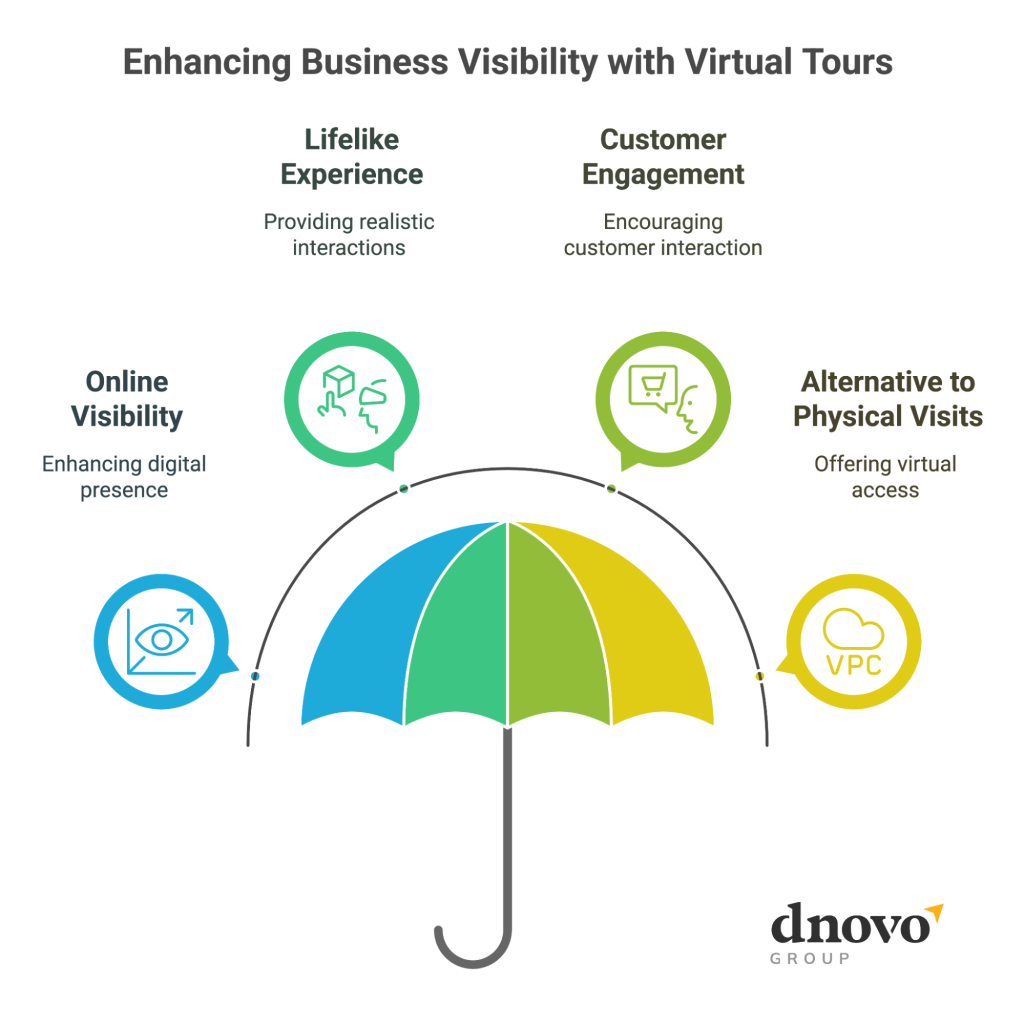
A virtual tour isn’t also about imitating an in-person experience. It becomes the experience, an information hotspot that invites customers inside, to interact with visually striking elements. As they navigate through, users adjust their expectations and visualize how your offerings align with their needs.
Shaping the Buyer’s Journey through an Immersive Experience
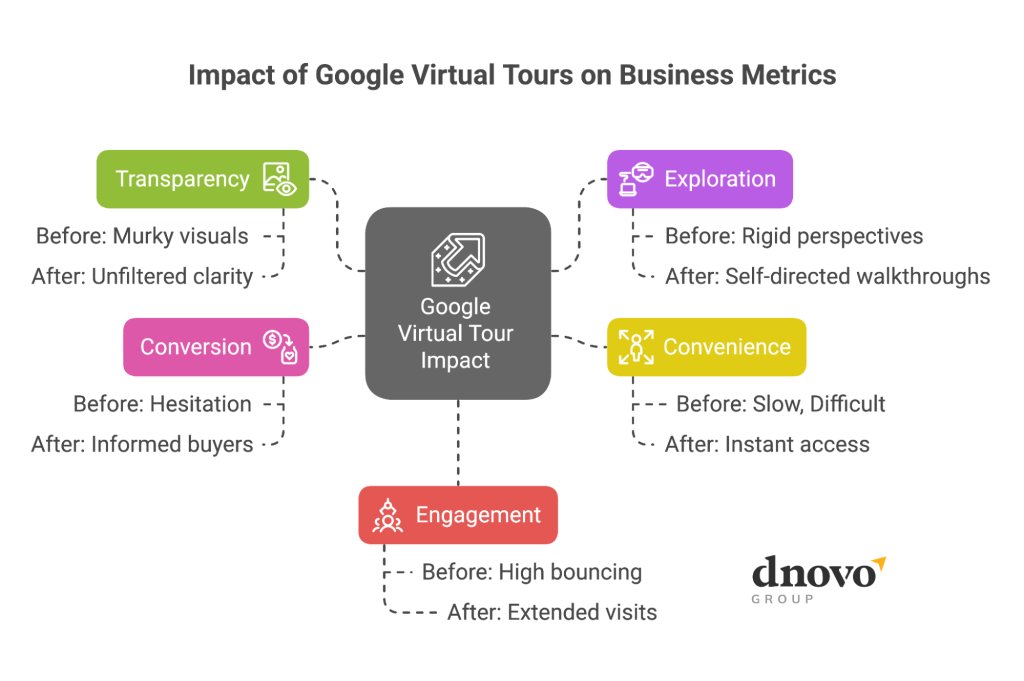
Here’s how the use of panoramic images, Google Maps, and street views can influence the buyer’s journey. Observe the transformation before and after the virtual tour experience:
Awareness stage – draw customers inside
At the beginning of their search, buyers are looking for information. They require various content formats. If you only present static images, basic text, or short descriptions on your website, the touchpoints will lack detail, so prospects engage only on a superficial level.
By offering virtual tours, you quickly capture their attention and demonstrate how you can assist them. Interactive storytelling creates a more dynamic connection, as a result, prospects seek further information about your business.
Consideration stage – stand out to customers
As buyers evaluate their options, they consider different brands. When offerings lack visual clarity, potential buyers experience fragmented interactions. They might visit a website, read reviews, and glance at some images or videos, but they aren’t immersed. This makes them uncertain about what makes you different from other brands. They have many unanswered questions.
With a 360-degree tour, you effectively close the knowledge and experience chasm. Prospective buyers gain a comprehensive understanding of what sets you apart from the competition.
Decision stage – make customers buy
Even if buyers are inclined to choose, they might still have doubts. They need further validation. If you haven’t shown them real-time evidence, they may hesitate and leave their purchases behind. A virtual tour allows buyers to make decisions with more confidence. They enjoy almost surreal visits, are captivated by what they see, and are motivated to invest. They finalize the checkout.
Toronto Businesses Emerging as Virtual Information Hotspots
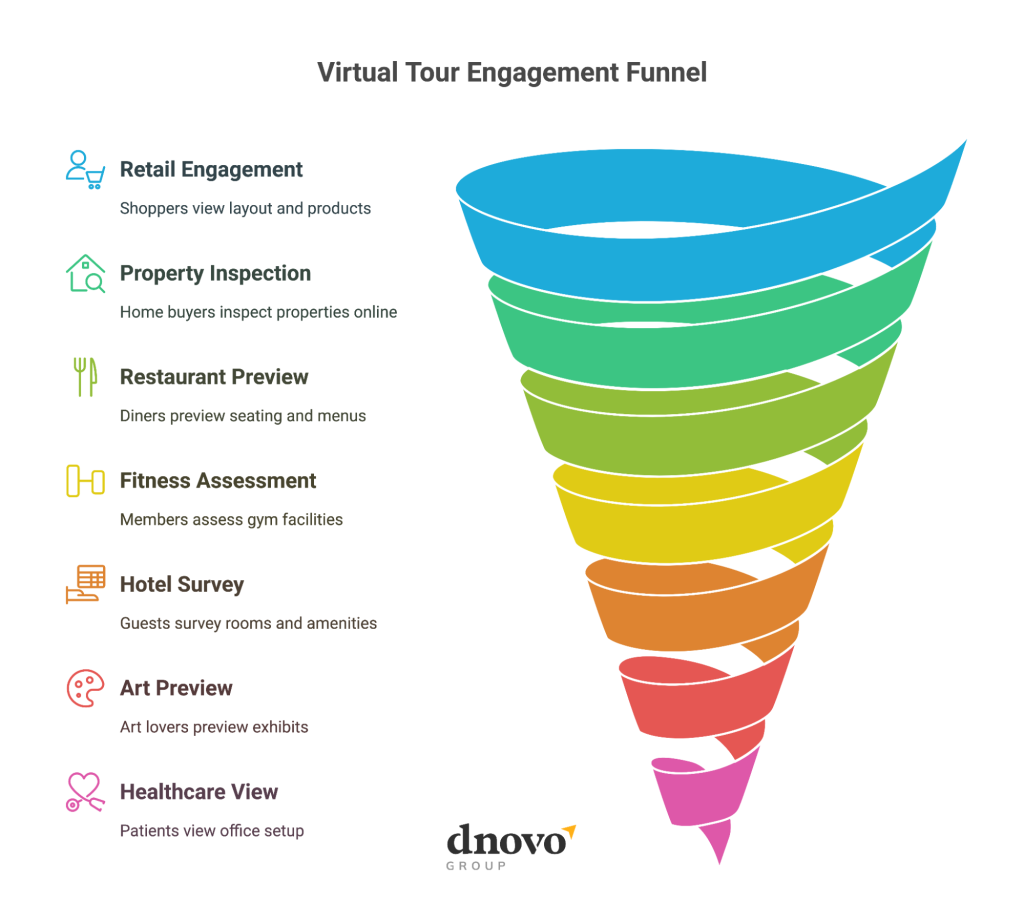
Across various e-commerce sectors in Toronto, businesses are discovering the power of Google Maps, panoramic images, and virtual tours to increase visibility and connect with more customers. Here’s how different industries are using these tools:
Retailers
Home buyers and renters find it challenging to assess properties through marketplaces. Most of these platforms don’t accurately represent what the properties look like. This makes visiting in person more frustrating, as potential tenants would only realize the property didn’t meet their expectations after making the trip.
Provide them with a virtual stroll into the physical elements that influence home-buying decisions:
– Property layout and flow
– Room sizes and proportions
– Natural lighting
– Flooring and finishes
– Ceiling height and architecture
– Storage spaces
– Kitchen and bathroom details
– Neighborhood and street views
– Entryways and accessibility
– Potential for customization
You’ll be making their visits more purposeful, leading to higher ratings and conversions, because customers already have a good idea of what they want.
Restaurateurs
Customers today are less willing to call and ask numerous questions about your restaurant, including details about prices and dining settings. Smoothen the reservation process by offering a look in these aspects before they come in:
– Ambiance & atmosphere
– Seating arrangements
– Cleanliness & maintenance
– Lighting & decor
– Outdoor seating
– Bar area & drink selection
– Restroom conditions
– Accessibility
– Event space or private dining
– Parking & location context
Keeping bookings lean and participatory results in quicker confirmations and fewer empty tables.
Fitness coaches
Fitness clients require something other than your prices to kindle their motivation. A huge part of what ticks them off is the location and availability of certain equipment. With 360-degree tours, you can show them:
– Gym space
– Group fitness rooms
– Equipment and machines
– Locker rooms and showers
– Personal training areas
– Pool and spa facilities
– Recovery and wellness services
– Accessibility and parking
– Community and atmosphere
This helps increase membership purchases and brand trust while cutting back disappointing first visits or cancellations.
Hoteliers
Since most guests’ cards are charged before check-in, it’s important to reduce issues with incorrect bookings. You can do so by putting your hotel on Google map so they see:
– Lobby and reception area
– Guest rooms & suites
– Event & conference spaces
– Dining & bar areas
– Outdoor spaces
– Technical facilities
– Leisure facilities
– Common areas & hallways
It is simply an effective method to maintain a good rating and review system among travelers and tourists.
Gallerists
A virtual tour gives you a great edge, especially when you want to convey a forward-thinking image for your gallery. Additionally, you can attract a broad spectrum of art and history fans by creating buzz around your:
– Exhibition layout & flow
– Artwork details
– Gallery size & space
– Wall text & signage
– Seating & rest areas
– Gift shop & merchandising
– Event space & special exhibits
The highlight comes when visitors find the same exceptional quality in the physical location. They take photos and share them with friends and family, further amplifying your brand awareness.
Healthcare providers
Modern patients are increasingly focused on efficiency and transparency, and telemedicine is making this easier than ever. As part of your telemedicine strategy, think about adding interactive panoramic images that illustrate:
– Reception & Waiting Areas
– Exam & Treatment Rooms
– Accessibility Features
– Specialized Areas
– Patient Flow & Wayfinding
– Parking & External Access
– Technology Integration
– Safety & Emergency Features
When patients have smooth interactions away from the hospital, they are more likely to keep their appointments and continue their care with you.
Best Ways to Integrate a Google Virtual Tour
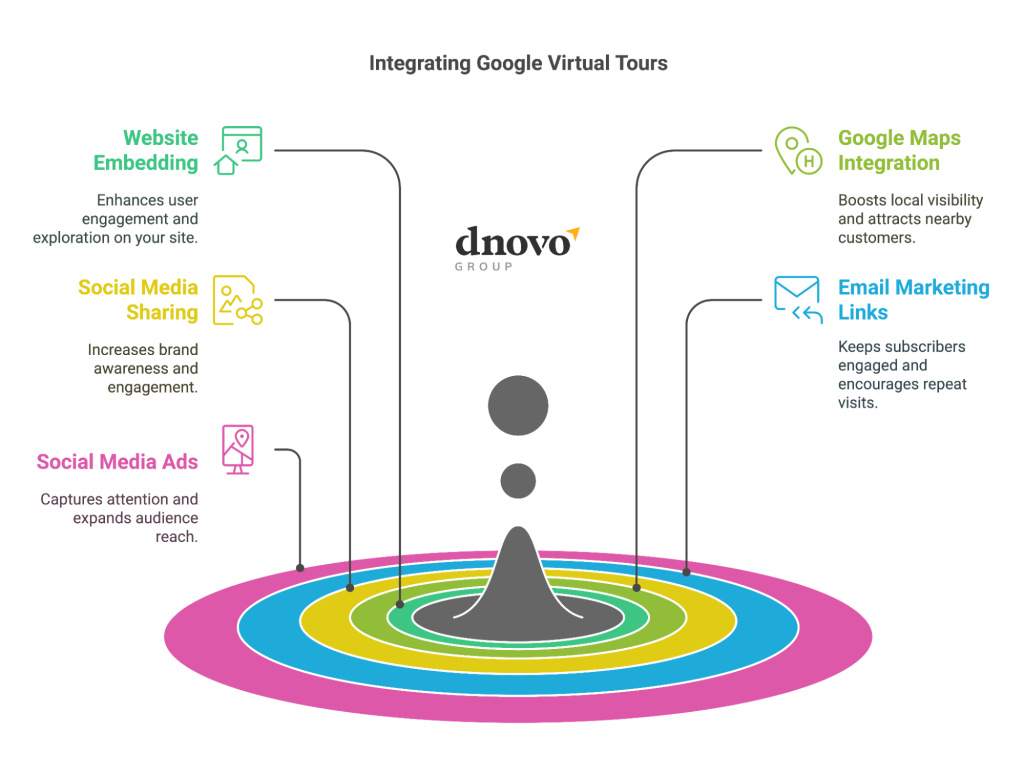
Website
With a Google Virtual Tour feature prominently added to your homepage and other important sections.
Google Maps & Google Street View
You can also embed links on a remote tour using Google Street View to improve local visibility. Customers can also find your business more easily on Google Maps and figure out how to get to you.
Social Media
Distribute snippets of your virtual tour on social media platforms. It tops off with organic marketing and social presence on Instagram, Facebook, and Twitter.
Emails
Emails are another avenue for connecting your subscribers with a digital walkthrough of your products and services.
Advertisements
Creative advertising through virtual tours can also be achieved with Facebook and Instagram ads.
The Stats: All the Benefits You Gain
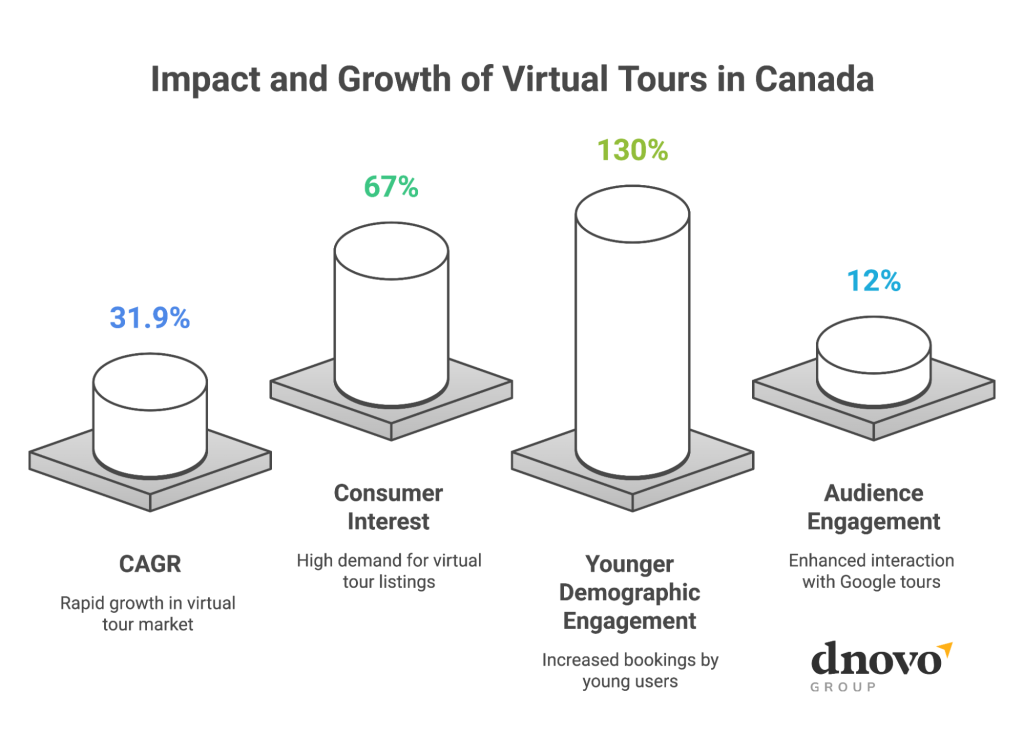
The market for virtual tours is rapidly expanding in Canada. Four key advantages include:
You tap into a growing landscape
According to Market Research, the Canadian virtual tour market is anticipated to grow at a Compound Annual Growth Rate (CAGR) of 31.9 percent from 2024 to 2031, indicating a strong adoption across multiple sectors.
You command greater attention
lCP Media suggests that listings that include virtual tours have been shown to double consumer interest, with users spending 5 to 10 times longer on websites that feature these immersive experiences.
You meet consumer demand
About 67 percent of consumers wish for more business listings to provide virtual tours, according to area360.com.au.
You attract Gen Zs and Millennials
Area360 also says that the younger demographic aged between 18 and 34 is 130 percent more likely to book a service or visit a location if a virtual tour is available.
You drive up engagement
Publishing your inventory on Google together with touring capabilities engages audiences by 12 percent more.
Get Your Business on the Map
Google Virtual Tours unlocks your brand’s comprehensive value. Propel your facilities into an immersive, boundary-pushing experience that captivates, converts, and ramps up foot traffic. Contact us now to schedule a consultation and integrate a Google Virtual Tour that can transform your business.




